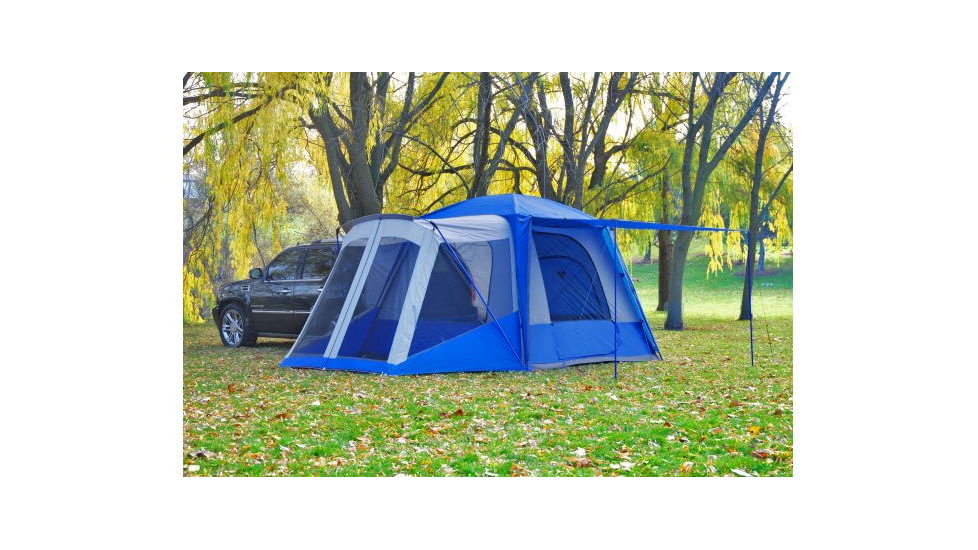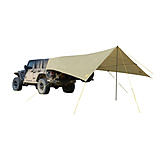Whether you're preparing for your first family camping trip or a backpacking journey on the Appalachian Trail, the most important step is choosing the right tent. I have camped all across the continental United States, learning firsthand the "dos and don'ts" of camping and backpacking. In order to narrow down your tent choices, there are several questions that you have to ask yourself: ![]()
- How are you going to be using the tent?
- Where and when are you going?
- How many people will be sleeping in the tent?
- How much money are you willing to spend?
Camping Tents vs. Backpacking Tents
Camping Tents
These types of tents are best for campers more concerned with an easy setup, spacious interior comfort, and for when Mother Nature is on your side. Although they can handle light storms, they lack several design features that help withstand the weather.
When camping at a campground, you will be near your car and won't have to haul a heavy tent very far. Many people look for a tent with tons of features and space, but this size adds weight. This is fine if you just have to pull it out of your trunk and set it up but not so great if you have to haul it on your back for many miles.
Camping tents use heavier nylon materials and offer luxury features like zip-down windows. Campground tents lack a vestibule where you cook and store camping gear if the weather is poor. However, you can sometimes add a vestibule to compatible camping tents. Tents in this category are not meant to be packed in a small size but rather put into their appropriate carrying case. This is not to say that camping tents are bad, as they offer much more interior area and headroom. If you want a home away from home feel and weight is not an issue, then a campground-style tent is for you.
Backpacking Tents
Backpacking tents are used when you have to walk many miles to a campsite and bad weather is a strong possibility. Backpacking and backcountry tents feature lightweight, heavy-duty rip-stop nylons. If you are backcountry camping or backpacking, then you’ll want a lightweight tent.
Several tent manufacturers allow you to use your hiking poles on the inside of the tent and several guy outs (points where you attach a thin rope to ground stakes to add strength) for the framework of the tent. Otherwise, the tents use lightweight aluminum poles in hoop configurations to give them a sturdy structure. Tents for backpacking have an emphasis on strength and weight; therefore, they do not have the large interior that you get with camping tents.
What Season Tent Do I Need?
Not every tent is made to withstand the same amount of abuse from Mother Nature. If you are going to be camping in the snow or there's a likelihood of it snowing during your trip, then you are going to want a four-season tent. Four-season tents are built using thicker materials and improved roof strength to deal with the added weight that snow brings. A three-season tent is ideal when you are not going to be dealing with snow.
Just like how you wouldn't wear shorts and sandals in fall, you need to pick a tent based on the temperatures you're going to be camping in. If you're camping in the tropics or warmer climates, a tent made of mostly vented mesh (Noseeum mesh) and a rain fly should be perfect for keeping the inside of your tent cooler.
As a rule of thumb, the higher you go up in elevation, the higher the nylon-to-Noseeum mesh ratio should be. This is because it tends to stay much cooler in areas 8,000 feet sea level or above. You should also expect to see higher winds at these elevations; therefore, you should also look into purchasing a robust exterior frame. This will eliminate a lot of the wind noise that would be very loud in tents without an external structure.
You can also purchase tent accessories like a tent rainfly or bug net to increase your protection against pests and inclement weather.
How Big of a Tent Do I Really Need?
How often you will be camping and how many people you'll be staying with in the tent with you can help determine a few things. If you want to sleep in a tent with another person and have plenty of space, then go with a tent made for three people. The same rule applies for more people sleeping in the tent: three people, then a four-person tent, and so on.
When tent weight is a concern, if two people are going to be sleeping in the tent, then purchase a two-person tent. You will ultimately have less room for your gear depending on your height and the overall dimensions of the tent, but the weight will be considerably less. I highly recommend that if you are traveling with a group of people and everyone is staying in the same tent, split up the components so everyone carries a part of the tent.
How Much Does an Average Tent Cost?
Unless you have a money tree in your front yard, then this might be one of the most important factors. Tents follow the same principles as everything else – you get what you pay for. If you want the strongest do-it-all tent, then plan on spending at least $300 or more. That is not to say that a tent that is less expensive won't keep you safe from the elements and still have the features you need.
It also depends on how many times a year you plan on going camping or backpacking. For people who camp only once or twice a year, a decent three-season tent in the $100-$200 price range will fulfill all your needs and more.
Takeaways to Pick the Best Tent
No matter what you choose, here are some important things that apply to every tent.
- No tent will excel in every climate and location, it is best to accept this and be willing to sacrifice certain features.
- Ounces equal pounds, and pounds equal pain. Cut weight where ever you can if you are going to be backpacking or backcountry camping.
- Spend the extra $15-$30 on some high-quality tent stakes and utility cords. Remember, the stakes and cord are what stop your tent from blowing away or failing in a storm.
- Always put a tent footprint down before setting up your tent. If your tent didn't come with a footprint, plan on buying one because they're your first layer of defense against rocks or twigs poking through the floor.
- Regardless if your tent comes from the factory with the seams sealed, purchase a bottle of seam sealer and do it again yourself.
- Clean your tent before putting it into storage.
- Store your tent in a cool and dry place to avoid mildew.
- Make sure you test out all of your camping gear before going on a trip.









